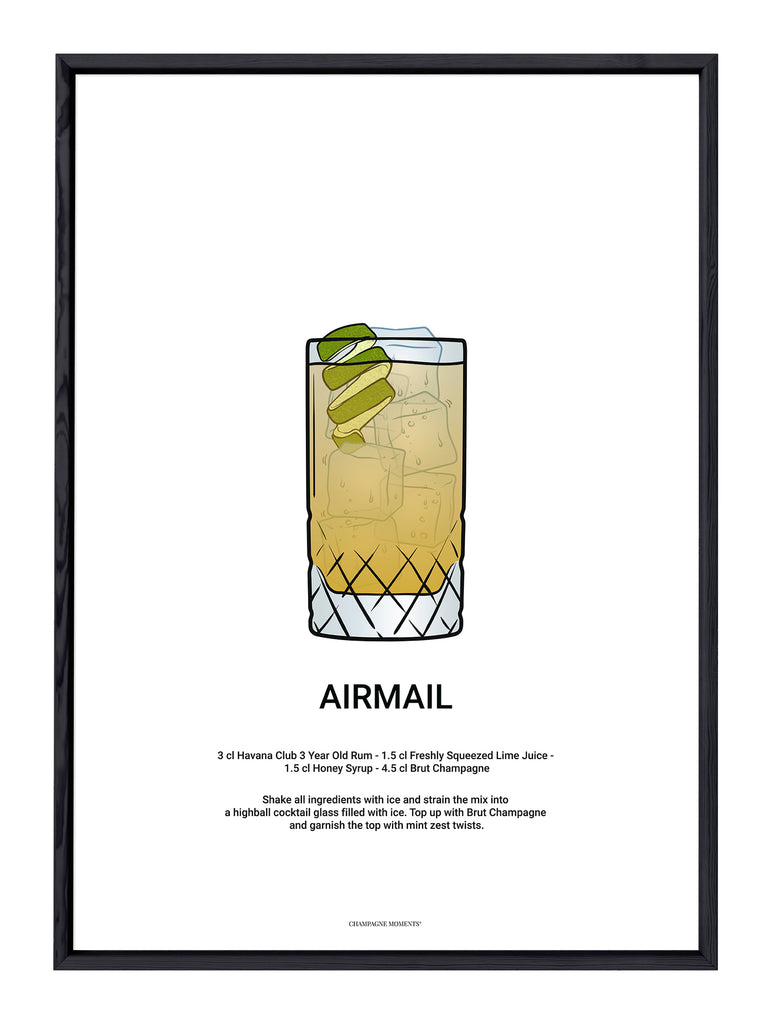
The mixture is then topped up with sparkling wine. The basis for the Airmail Cocktail is a sour mixture of rum, lime juice and honey (or honey syrup), which are first shaken on ice in a cocktail shaker and then strained into a pre-cooled Cocktail glass. In the 2010s, however, the cocktail experienced another boom by being mentioned in the ‘ PDT Cocktail Book’ (2011) and by the promotion of alcoholic drinks by the brand Bacardí. In the following decades, the cocktail wasn't very popular, having been published rarely. The cocktail gained further popularity when the recipe was mentioned in the Handbook for Hosts in Esquire magazine in 1949. As far as the Airmail Cocktail is concerned, Whitfield commented on it ‘It ought to make you fly high’.

Whitfield had collected numerous drinks from the years of prohibition and provided them with comments partly in laconic style. In his recipe collections, Just Cocktails (1939) and Here's How (1941), the author W.C. In 1941, the recipe was published in a mixology book. Shortly after, the Airmail Cocktail appeared for the first time in an advertising brochure of the then still Cuba-based rum manufacturer Bacardí. Since 1925, flights were available from Key West to Havana, and in 1930, a regular airmail service was established to and from the island. Cuba, among other countries, benefited from this as a pronounced bar and cocktail culture began developing on the island in the 1920s. Because of prohibition, Americans were only able to legally drink alcohol abroad until 1933. In those years when international telephone connections were still a rarity, airmail was the fastest means of communication across national borders. in the 1920s or 1930s.Īs with the slightly older Aviation cocktail, to whose recipe there is no similarity, the name is reminiscent of aviation which developed rapidly at that time. It was probably created during or shortly after the period of prohibition in the United States of America or on Cuba, i.e. The Airmail or Air Mail (also Airmail cocktail) is a classic cocktail based on rum, lime or lemon juice, honey, and sparkling wine. Rum notes come through subtly on the finish for a complex flavor profile.Airmail Cocktail, garnished with a postal stamp The champagne and lime create a crisp flavor while the honey softens the bite. The Airmail combines the strong flavors of rum, honey syrup, lime and champagne in a way that perfectly balances sweet, sour and effervescent. Bacardi exclusively comes out of Puerto Rico instead of Cuba now, and we find that it makes a drink that’s just as refreshing and satisfying. The Airmail is now categorized as a vintage cocktail that you don’t often see on modern menus-maybe because of the saturation of cocktails available, the pricey postage stamp garnish or the fact that you can’t get real Cuban rum in the United States. Because the Airmail doesn’t make an appearance in any literature before Bacardi’s pamphlet, and the dates match up historically, they should probably get the credit. This pamphlet was released almost a decade before Whitfield’s book was published. Shortly after the first flight in Cuba, Bacardi Cuban Rum mentioned the Airmail cocktail-which was garnished with a real postage stamp-in their promotional pamphlet. Cuba was not going to be left behind, so they started their own regular Airmail service in 1930. That may not seem revolutionary now, but at the time, it was a marvel of modern mail.

It flew from Santa Rosa to Petaluma, California with three official pieces of correspondence. The first attempt at Airmail (the postal service, not the drink) was in 1911.

Because gold Cuban rum was the original base for the cocktail, it only makes sense to start there for an origin story. Was Whitfield the creator of this fruity, bubbly concoction meant to send you into the sky? To get the answer, it’s best to consult the ingredients. Although Esquire was considered the first, Whitfield had written about the Airmail eight years prior in 1941.
#Airmail cocktail how to#
It’s been explained many ways since that early description, including the “Carbibbeanized French 75” and “ Daiquiri with a champagne honey punch.” Like so many famous cocktails from the 40s and 50s, where the Airmail came from and who created it is up for debate.įor many years, it was believed that the first written acknowledgment of the Airmail cocktail was in Esquire’s 1949 edition of Handbook for Hosts, which was a source on how to throw the perfect soiree from drinks and games to hors d’oeuvres and decorations. Whitfield in his go-to guide Here’s How, Mixed Drinks. “It ought to make you fly high” was way the Airmail cocktail was described by master bartender W.


 0 kommentar(er)
0 kommentar(er)
